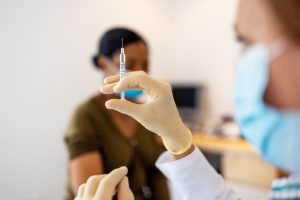As hospitals cope with the simultaneous strains of limited resources and supply chain disruptions, efficiency is more important than ever before in all areas of the hospital, and the catheterization lab is no exception.
With technologies available to the healthcare market, how do healthcare decision makers make the right call when implementing a new technology—one that will provide them with a return on their investment, much needed administrative relief, and enhanced patient safety?
The answer is UHF RFID.
RFID and QSight by Owens & Minor are a Complimentary Combo
RFID technology is already ubiquitous in many industries, and its value is now being recognized and adopted rapidly in healthcare. Ultra-high frequency radio frequency identification (UHF RFID) is a wireless technology that uses radio waves to automatically capture product-level details within a department through the use of an RFID antenna and RFID tags placed on applicable items.
In cath labs, RFID systems are particularly beneficial because the scope of procedures they perform is expanding and the inventory being managed is high value. However, RFID is not a standalone inventory management solution. The end user needs the right blend of hardware and software capabilities to maximize the proven cost-savings that RFID can help achieve.
“For RFID to work in the cath lab, it has to be combined with a software solution like Owens & Minor’s QSight, which provides visibility to the data the RFID hardware collects and presents it to the user in an intuitive manner.” says John Crankshaw, Technology Applications Director, Owens & Minor.
How can RFID technology help cath labs optimize the way they track inventory?
RFID technology can enhance established systems and processes to further improve inventory control and visibility, but its real power is unleashed when combined with a powerful inventory management solution.
When RFID technology is used in conjunction with QSight, cath labs are able to track these high-value products with the use of large RFID cabinets. These smart cabinets keep track of products as they are removed or added and by whom, with the data transferred automatically to QSight. This eliminates the need for manual intervention by clinical staff and provides:
- Real-time visibility: Hospital staff can see what products are on hand, what products have been added or removed, and what products are in need of replenishment without manual data entry. Furthermore, inventory controllers are able to quickly identify who took what, from where, when, allowing them to immediately react to daily events.
- Improve consigned inventory: As the types of procedures that take place in cath labs continues to expand, a greater variety of products are needed on hand and many of these items in stock are consigned. Having real-time visibility into consigned products allows hospitals to make data-driven decisions about the products they use most, and which products typically sit on shelves the longest. This reduces panic-based stocking practices and allows for a more strategic approach to managing inventory.
- Manage recalled and expired products easily: RFID gives cath labs the information they need to proactively reduce waste and improve patient safety. Staff can instantly see, via the QSight Alerts page, a recalled or expired product’s location and remove it from inventory before it ever reaches a patient. In addition, they can see when a product is nearing expiration so they can avoid unnecessary costs due to unused products.
RFID-enabled cabinets enable powerful inventory tracking
Cath labs looking at an RFID solution should look for one that combines RFID technology with a powerful inventory management solution like Owens & Minor’s QSight. QSight offers a full range of RFID-enabled cabinets powered by Terso Solutions, a leader in the production and implementation of UHF RFID.
“One of the advantages of QSight is that it easily integrates with Terso cabinets,” Crankshaw said. “With this integration, QSight users can see the counts from the RFID cabinets, see what products are missing, what products are there that aren’t supposed to be there and so much more. It really is a simple, yet powerful way for cath labs to keep track of inventory,” Crankshaw continued.
RFID technology is increasingly being embraced by cath labs to keep track of high-dollar products, like balloons, stents, and valves. However, cath labs shouldn’t look at RFID technology alone. Instead, cath labs should look at both the RFID technology and the underlying inventory management solution that the RFID technology is integrated with. It’s through that combination that cath labs will see the greatest benefits of RFID technology.
Reach out to Owens & Minor today to get started on establishing a source of truth for your data reporting, and to receive actionable insights.
QSight: Inventory Management for Procedural Supply Chain
Improve inventory visibility and reduce costs with our revolutionary cloud-based healthcare inventory management system.
















